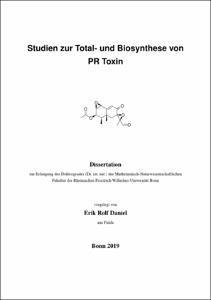Studien zur Total- und Biosynthese von PR Toxin

Studien zur Total- und Biosynthese von PR Toxin

| dc.contributor.advisor | Dickschat, Jeroen S. | |
| dc.contributor.author | Daniel, Erik Rolf | |
| dc.date.accessioned | 2020-04-27T15:11:32Z | |
| dc.date.available | 2020-04-27T15:11:32Z | |
| dc.date.issued | 06.03.2020 | |
| dc.identifier.uri | https://hdl.handle.net/20.500.11811/8286 | |
| dc.description.abstract | Diese Arbeit beschäftigt sich mit dem Pilzgift PR Toxin, welches aus Penicillium roqueforti isoliert werden kann. Es wurden einerseits drei Ansätze für eine Totalsynthese entwickelt und andererseits grundlegende Arbeiten zur Entschlüsselung der Biosynthese durchgeführt. Der Aufbau des Grundgerüsts war im ersten Syntheseplan mithilfe einer Gilman-Reaktion, einer Robinson-Annelierung und einer Ozonolyse erfolgreich. Zur Einführung der im PR Toxin enthaltenen Alkoholgruppe konnte die Oxidation von (S)-Carvon an den Anfang der Synthese gestellt werden. Nach Schützung der daraus resultierenden Alkoholgruppe schloß sich eine Gilman-Reaktion mit dem Elektrophil 3-Brompropionsäureethylester an. Darauf folgte die Fujimoto–Belleau Sequenz. Weiterhin wurde eine neue Art der Gilman-Cascaden-Reaktion entdeckt. Bei dieser wird innerhalb von einer Stufe aus einem monozyklischen Enon ein Trizyklus gebildet und fünf Stereozentren definiert. Ein Mechanismus konnte in dieser Arbeit vorgeschlagen werden. Das Produkt dieser Reaktion war Grundlage für den dritten totalsynthetischen Ansatz. Um die Biosynthese besser zu verstehen, wurde mRNA aus Penicillium roqueforti isoliert und mithilfe der reversen Transkriptase in cDNA umgewandelt. Die Exprimierung in E. coli gelang nur im Falle der Aristolochensynthase. Die anderen Enzyme aus dem entsprechenden Gencluster waren trotz verschiedener Versuche nicht in E. coli exprimierbar. Aus diesem Grund wurden erste Schritte zur heterologen Expression in A. oryzae unternommen. Somit gelang es die Grundlagen für die Totalsynthese und die Charakterisierung der Biosynthese von PR Toxin zu legen und eine neue synthetische Methode zu charakterisieren. | en |
| dc.description.abstract | This work deals with the fungal toxin PR Toxin, which can be isolated from Penicillium roqueforti. On the one hand three approaches for a total synthesis were developed and on the other hand basic work for the decoding of the biosynthesis was carried out. In the first synthesis plan, the bicyclic system was successfully constructed using a Gilman reaction, a Robinson annneliation and an ozonolysis. For the introduction of the alcohol group contained in the PR toxin, the oxidation of (S)-carvone could be placed at the beginning of the synthesis. After protection of the resulting alcohol group a Gilman reaction with the electrophile 3-bromopropionic acid ethyl ester followed. This was followed by the Fujimoto-Belleau sequence. Furthermore, a new type of Gilman-Cascade reaction was discovered. In this reaction a tricycle is formed from a monocyclic enone within one step and five stereo centers are defined. A mechanism could be proposed in this work. The product of this reaction was the basis for the third total synthetic approach. To better understand the biosynthesis, mRNA was isolated from Penicillium roqueforti and converted into cDNA using reverse transcriptase. The expression in E. coli was only possible in the case of Aristolochensynthase. The other enzymes from the corresponding gene cluster could not be expressed in E. coli despite various attempts. Therefore, first steps towards heterologous expression in A. oryzae were taken. Thus, the basis for the total synthesis and characterization of the biosynthesis of PR toxin was established and a new synthetic method was characterized. | en |
| dc.language.iso | deu | |
| dc.rights | In Copyright | |
| dc.rights.uri | http://rightsstatements.org/vocab/InC/1.0/ | |
| dc.subject | PR-Toxin | |
| dc.subject | Totalsynthese | |
| dc.subject | Gilman-Reaktion | |
| dc.subject | Robinson-Anellierung | |
| dc.subject | Ozonolyse | |
| dc.subject | Epoxidation | |
| dc.subject | Fujimoto-Belleau-Sequenz | |
| dc.subject | Gilman-Kaskaden-Reaktion | |
| dc.subject | Trizyklus | |
| dc.subject | Biosynthese | |
| dc.subject | mRNA | |
| dc.subject | reverse Transkriptase | |
| dc.subject | heterologe Expression | |
| dc.subject | E. coli | |
| dc.subject | A. oryzae | |
| dc.subject | Terpencyclase | |
| dc.subject | Cytochrome P450 | |
| dc.subject | Transferase | |
| dc.subject | DUF3237 | |
| dc.subject | total synthesis | |
| dc.subject | Gilman reaction | |
| dc.subject | Robinson anellation | |
| dc.subject | ozonolysis | |
| dc.subject | Fujimoto-Belleau sequence | |
| dc.subject | Gilman cascade reaction | |
| dc.subject | tricycle | |
| dc.subject | biosynthesis | |
| dc.subject | reverse transcriptase | |
| dc.subject | cDNA | |
| dc.subject | heterologous expression | |
| dc.subject | terpene cyclase | |
| dc.subject.ddc | 540 Chemie | |
| dc.subject.ddc | 570 Biowissenschaften, Biologie | |
| dc.title | Studien zur Total- und Biosynthese von PR Toxin | |
| dc.type | Dissertation oder Habilitation | |
| dc.publisher.name | Universitäts- und Landesbibliothek Bonn | |
| dc.publisher.location | Bonn | |
| dc.rights.accessRights | openAccess | |
| dc.identifier.urn | https://nbn-resolving.org/urn:nbn:de:hbz:5-57555 | |
| ulbbn.pubtype | Erstveröffentlichung | |
| ulbbnediss.affiliation.name | Rheinische Friedrich-Wilhelms-Universität Bonn | |
| ulbbnediss.affiliation.location | Bonn | |
| ulbbnediss.thesis.level | Dissertation | |
| ulbbnediss.dissID | 5755 | |
| ulbbnediss.date.accepted | 31.01.2020 | |
| ulbbnediss.institute | Mathematisch-Naturwissenschaftliche Fakultät : Fachgruppe Chemie / Kekulé-Institut für Organische Chemie und Biochemie | |
| ulbbnediss.fakultaet | Mathematisch-Naturwissenschaftliche Fakultät | |
| dc.contributor.coReferee | Menche, Dirk |
Dateien zu dieser Ressource
Das Dokument erscheint in:
-
E-Dissertationen (4442)




